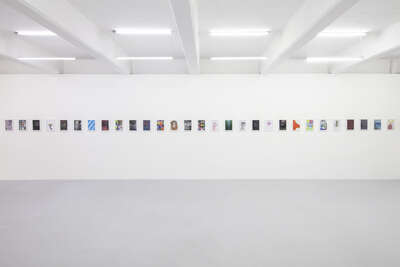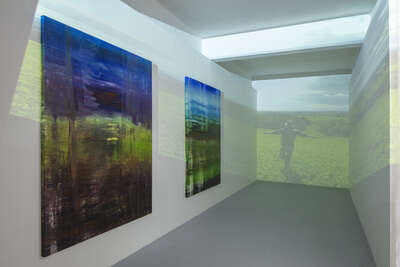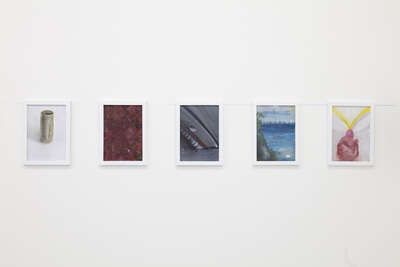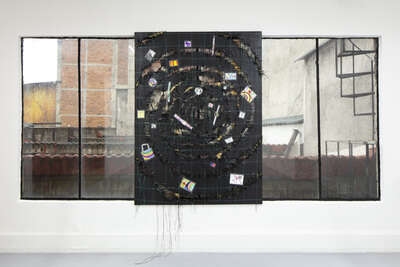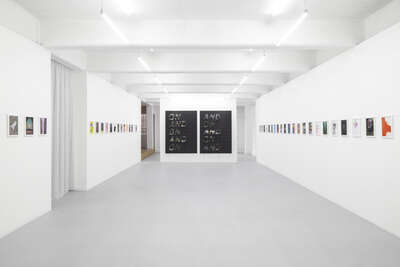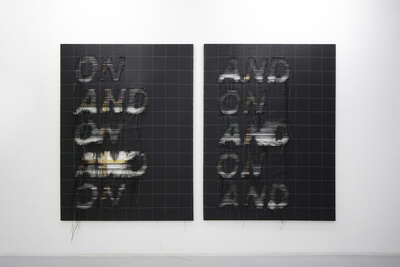LUGAR ENTRE LUGARES
June 19 - August 2, 2025
On the back part of the step, toward the right, I saw a small iridescent sphere of almost unbearable brilliance. At first I thought it was revolving; then I realised that this move- ment was an illusion created by the dizzying world it bounded. The Aleph’s diameter was probably little more than an inch, but all space was there, actual and undiminished. Each thing (a mirror’s face, let us say) was infinite things, since I distinctly saw it from every angle of the universe.
Jorge Luis Borges, The Aleph.
Lugar entre lugares (a place amongst or between places) can refer to the most exceptional place of all places, the one we have chosen, the most subjectively our own, the one that holds the links that move us from one place to another. It may be a place between two places, an intermediate, blurred, or transitory space, the passage from one nucleus to another. Or it can be a place that encompasses all the places in the world, a vanishing point from which all realities and times can be glimpsed simultaneously.
Andrew Birk’s Lugar entre lugares is simultaneously a journey, a root, and a horizon. Driven by a rotating movement that goes through a succession of gestures, it is the path of stoic conviction and ceaseless, looping research. Within this helical force lies a common thread that weaves the text of the journey: the supernatural that hides in the everyday. The encounters with ordinary, vulgar, and base events are transformed by a cu- rious and attentive eye that exponentially magnifies them into magical conjunctions with results that are as evident as they are stupefying.
Unfolding in three acts, the relationship between physicality and the work’s surface is manifested in the movement of rotation, repetition, and tearing. In this trajectory, Andrew Birk uses circumstantial restrictions as conditions, transforming obstacles into objectives to overcome in the exercise of confrontation with paint- ing. The self-imposed dynamic of conquering limitations is the backbone of a succession of materialities, where the method becomes the language and the action resonates on the surface.
Starting and closing the circuit, the recent Chainsaw paintings explode the notion of scale between subtlety and danger, detail and perspective, between skill and brutality. Using landscaping fabric on a stretcher ripped with a chainsaw, forcefulness and precision coexist as an index of existential fervor. The writing, calculated and unwoven as radically as they are scrupulous, insist once again on the circularity of all movement: On and on and on and on dilutes the idea of a beginning and an end, and connects the dots in a spiral form, from the inside out and in all directions.
In the main hall, and presenting for the first time the magnitude of this long-term latent project, the endless collection of Watercolors on paper extends as a reiterative exercise in elevating the unexpected symmetry of trivial equilibriums to an ever-unfinished conversation about the transcendent. Each piece contains not only a fragment of a story seen through a microscope, but also the contingency of the millions of potential narra- tives that emerge in the relationship of one fragment to another.
Spin paintings closes the trilogy with the repeated action of spinning until you lose your way, until the body falls, overcome by the hazy confusion of the landscape seen at high speed. Here, the point of view is reversed, unlike in Borges’s story: now, the eye is the point that turns, avoiding capturing the image of reality in a fixed and motionless impression, but instead seeking clairvoyance through disorientation.
Sira Pizà
En la parte inferior del escalón, hacia la derecha, vi una pequeña esfera tornasolada, de casi intolerable fulgor. Al principio la creí giratoria; luego comprendí que ese movimiento era una ilusión producida por los vertiginosos espectáculos que encerraba. El diámetro del Aleph sería de dos o tres centímetros, pero el espacio cósmico estaba ahí, sin disminución de tamaño. Cada cosa (la luna del espejo, digamos) era infinitas cosas, porque yo claramente la veía desde todos los puntos del universo.
Jorge Luis Borges, El Aleph
Un Lugar entre lugares puede ser el lugar más excepcional de entre todos los lugares, aquél que hemos escogido, el más subjetivamente propio, el que encierra los vínculos que nos mueven de un lado a otro. Puede ser un lugar entre dos lugares, un espacio intermedio, borroso o de tránsito, el paso de un núcleo a otro. O puede ser un lugar que engloba todos los lugares del mundo, un punto de fuga desde donde se pueden vislumbrar todas las realidades y tiempos simultáneamente.
Lugar entre lugares de Andrew Birk es al mismo tiempo recorrido, raíz, y horizonte. Remolcado por un movimiento giratorio que atraviesa la sucesión de gestos, es el camino de la convicción estoica y la búsqueda en bucle incesante. En esta fuerza helicoidal existe un hilo conductor que teje el texto de la trayectoria: lo sobrenatural de lo cotidiano. Los encuentros con hechos ordinarios, vulgares o inmundes están transformados por la atención curiosa que los magnifica exponencialmente en conjunciones mágicas de resultado tan evidente como aturdidor.
Desplegado en tres actos, la relación de la fisicalidad con la superficie de la obra se manifiesta en el movimiento de giro, de repetición y de desgarro. En esta trayectoria, AB utiliza restricciones circunstanciales como condiciones, convirtiendo los obstáculos en objetivos a superar en el ejercicio de confrontación con la pintura. La dinámica autoimpuesta de superar las limitaciones es la columna vertebral de una sucesión de materialidades, donde el método se convierte en el lenguaje y en la superficie resuena la acción.
Iniciando y cerrando el recorrido, la reciente serie Chainsaw paintings explota la noción de escala entre lo delicado y lo peligroso, el detalle y la vista de pájaro, la destreza y la brutalidad. Utilizando tela de jardinería sobre bastidor rasgada con una motosierra, la contundencia y la precisión coexisten como un índice de fervor existencial. Las letras, calculadas y desfiladas tan radical como escrupulosamente, vuelven a insistir en la circularidad de todo movimiento: On and on and on and on diluye la idea de un principio y un fin, y conecta los puntos en una forma espiral, de dentro hacia afuera y en todas direcciones.
En la sala principal, y presentando por primera vez la magnitud de este proyecto latente de larga duración, la interminable colección de Acuarelas sobre papel se extiende como un ejercicio reiterativo de elevar la simetría inesperada de los equilibrios triviales a una conversación siempre inacabada sobre lo trascendente. Cada pieza contiene no solamente el fragmento de una historia vista en el microscopio, sino también la contingencia de los millones de narrativas potenciales que surgen en la relación de unos fragmentos con otros.
Spin paintings cierra la trilogía del giro con la repetida acción de voltear hasta perder el norte, cayendo el cuerpo abatido por la nebulosa confusión del paisaje visto a alta velocidad. El punto de vista se invierte, al contrario que en el cuento de Borges: el ojo es aquí el que gira, evitando captar la imagen de la realidad en una impresión fija e inmóvil, buscando la clarividencia a través de la desorientación.
Sira Pizà

